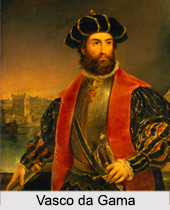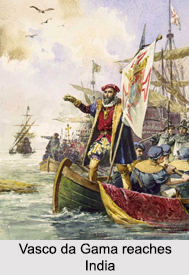 Vasco da Gama was one of the notable Portuguese explorers who discovered a sea route from Portugal to the East. On the 27th of May 1498, Vasco da Gama stepped ashore on the coast of Malabar, and for Kerala a new era began. His discovery of this sea route helped the Portuguese establish a long-lasting colonial empire in Asia and Africa. The new ocean route around Africa allowed Portuguese sailors to avoid the Arab trading hold in the Mediterranean and Middle East.
Vasco da Gama was one of the notable Portuguese explorers who discovered a sea route from Portugal to the East. On the 27th of May 1498, Vasco da Gama stepped ashore on the coast of Malabar, and for Kerala a new era began. His discovery of this sea route helped the Portuguese establish a long-lasting colonial empire in Asia and Africa. The new ocean route around Africa allowed Portuguese sailors to avoid the Arab trading hold in the Mediterranean and Middle East.
Early Life of Vasco da Gama
Vasco da Gama was born in 1460 to a minor nobleman who commanded the fortress at Sines, Portugal. His career as an explorer started after his father was selected to lead an expedition to open the sea route to Asia and to outflank the Muslims, who enjoyed a monopoly of trade with India and other eastern states. He took command when his father died and sailed from Lisbon in the month of July 1497. The patron of Vasco da Gama was King Manuel I of Portugal. Vasco da Gama"s maritime career was during the period when Portugal was searching for a trade route around Africa to India.
 Vasco da Gama in India
Vasco da Gama in India
Vasco da Gama made two expeditions to India between 1497 and 1524. In 1497, King Manuel I chose da Gama to lead a Portuguese fleet to India in search of a maritime route from Western Europe to the East. At the time, the Muslims held a monopoly of trade with India and other Eastern nations. Vasco da Gama sailed from Lisbon in July 1497. Many explorers made several attempts. It was Bartolomeu Dias who was the first to round Africa and make it to the Indian Ocean in 1488. But he was forced to head back to Portugal before he could make it to India. Vasco da Gama rounded the Cape of Good Hope, and anchored at Malindi on the east coast of Africa. With the aid of an Indian navigator, Vasco da Gama was able to cross the Indian Ocean and reach the coast of India at Calicut (now Kozhikode) in May 1498.
For the next 20 years, Vasco da Gama continued to advise the Portuguese ruler on Indian affairs. In 1524, King John III appointed him as Portuguese viceroy in India with the task of combating the growing corruption that had tainted the Portuguese government in India. Vasco da Gama arrived in Goa but soon fell ill, and in December 1524 he died in Cochin. He was buried in the local church. In 1539, his remains were brought back to Portugal.
Vasco da Gama, more than most men whose names seem prominent in history, was an instrument of forces mainly beyond his own control or even comprehension.






































